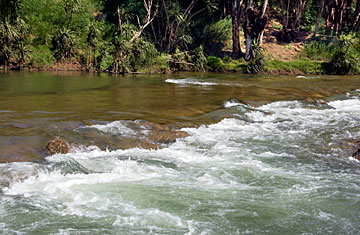
In a big wet season, the Daly can rise up to 20m, forcing Nauiyu residents to evacuate. But the floods bring wildlife in abundance
"See the crocodiles?" Rosita Murindett points across the green river. Sandy bank, a couple of gray logs. No, not logs — one just moved. Crocs are the reason residents of Nauiyu Nambiyu don't swim in the river nowadays. And why, when they go to the nearby billabong to catch turtles, they throw a stick in the water first, scan the surface for bubbles, and always post a lookout. Crocodiles are protected in the Northern Territory, though Aboriginal people are permitted to hunt them for food. "The meat is really nice," says Rosita. But some of the older people avoid it. What if they ate a crocodile that had once eaten one of their relatives? There's an easier way to enjoy croc. Rosita points out a tall tree with a spiny trunk: "When the kapok trees' red flower comes out" — just before the wet season — "we know the freshwater crocodiles are laying eggs here. So we go and collect them."
When Steve Sunk looks at a crocodile, he thinks recipes. Crocodile frittata, maybe, with some peppery wild spinach. Or char-grilled crocodile tail with a nice chutney of bush tomato and mango. A cooking lecturer at Darwin's Charles Darwin University, Sunk has spent the past 14 years dreaming up tasty ways to cook bush tucker and teaching those ways to Aboriginal people. He started his Back to Basics course as a way to break the hold of takeaway food. "There are communities around here that still go through 100 kg of fried chicken a day and 10 kg of chips. That's all they eat," says Sunk, who manages to be passionate without seeming to preach. Even children were getting heart disease. With support from Aboriginal elders, Sunk set out to get people eating bush foods again. He's now taught 1,300 Aboriginal cooks about carbs and calories: "They know now that eating fat is bad for you." And about stir frying, stewing and soup making. "Take wallaby — they used to just throw it on the fire and it's all gone," he says. "We show them how to cut it up, pack and freeze it, and cook it in different ways," using community-store staples like rice and soy sauce.
Sunk recently published a collection of his recipes in a book called Walkabout Chefs. But his students, he says, have taught him at least as much as he's taught them. And none more than his first class, the women of Nauiyu (formerly Daly River Mission), 300 km southwest of Darwin. They had a head start with his program, he says, because "they're very modern, but they still go out and get bush tucker. Their knowledge of the river and the billabongs and the plants and animals is amazing."
In the community art gallery, a huge painting of a crocodile's eye glowers alongside images of barramundi, water pythons, turtles, stingrays, prawns, water lilies, bush plums and yams. For most artists, nature is beauty. For Nauiyu's artists, it's also food. And no wonder: the flood plains of the mighty Daly, which become a vast lake when it spills its banks each wet season, are among the most productive ecosystems in the world. From one November to the next, as the river's waters swell and then subside into a necklace of creeks and billabongs, the plants and animals that depend on it go through their own cycles of abundance and scarcity. "Every month something happens," says Sunk. "It's like a bush calendar."
Now, as the billabongs begin to dry out, is the time of the waterlily and the long-necked turtle. Every part of the pink and white lilies is eaten, from their potato-like bulbs to their celery-crisp stems and seeds. Rosita and Loretta Marranya, both teaching assistants, pick lilies while they hunt for long-necked turtles, walking "gently, with small steps" as they feel with their toes for shells buried in mud. When the billabong dries up, Rosita says, the turtles will stay dug in. "Then, we poke the ground with a stick or look for air holes." Sometimes probing toes encounter smaller shells — tasty black mussels. And if they want some fish, "you can crush the leaves of the itchy tree" — the freshwater mangrove — "then drop them in the water," and pick up the stunned fish in your hands.